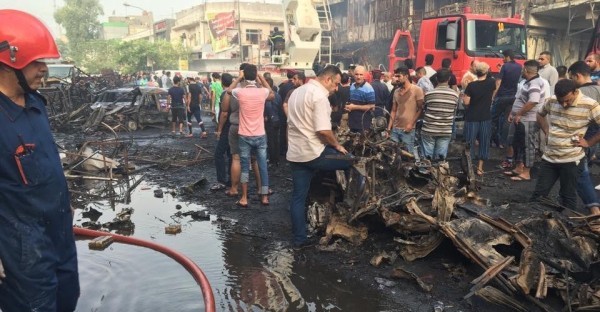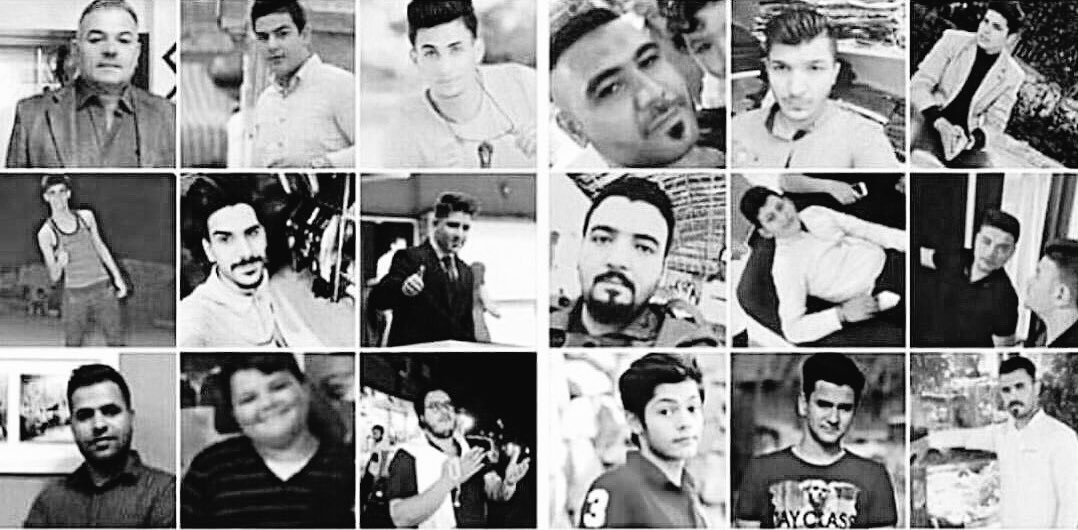PHOTO: The photos of some of the victims of Sunday’s bombing of Karrada in Baghdad
On Sunday, at least 200 people were killed and more than 200 wounded by an Islamic State car bombing of Karrada in the heart of Baghdad.
Balsam Mustafa of the University of Birmingham writes for EA, in partnership with The Conversation:
“I’m happy that I graduated. I’m so grateful to my parents and I dedicate my success to both of them.”
These were the final words written by Adnan, a victim of Sunday’s deadly attack in the crowded, buzzing street of Karrada at the heart of Baghdad. Adnan, like many other young victims, was celebrating his success when he posted on his Facebook page a few days earlier. He could not predict, nor could his loved ones, nor could any of the dead that their simple dreams would end so early.
Karrada’s attack took place when an explosives-laden track exploded near a restaurant and multi-story shopping center where people were shopping for Eid, the festival ending the holy month of Ramadan. The explosion was so large that it set fire to adjacent buildings and stores.
See Iraq Feature: 131+ Killed in 2 Baghdad Car Bombs
Blocked roads around the area delayed the arrival of firemen and ambulances by approximately 20 minutes. Trying to escape the blaze, young people who gathered to watch the quarterfinals of the European Football Championship were trapped on the roof until they burned to death or suffocated. Until late Sunday, burnt bodies were still being removed from the rubble of the destroyed buildings. With official crews overwhelmed by the task, local people took on the grisly duty.
Facing the Sectarian Narrative
Despite claims by the Islamic State that it was mainly targeting Shias, the attack on Karrada was against all Iraqis, be they Shia, Sunni, or Christian. Although it is a mainly Shia-inhabited area, Karrada is home to many of other faiths. A popular commercial destination and a famous cultural hub, it is an attraction for all Iraqis in the capital and beyond, known as “the bride of Baghdad”.
The Islamic State cloaks its attack on every Iraqi through the sectarian narrative that it promoted before and after its self-proclaimed Caliphate in July 2014. Its derogatory language escalates in response to military defeats on the ground, in this case the recapture by Iraqi forces of the city of Falluja last week. Unfortunately, far from being challenged, the narrative is recycled in the “Shias v. Sunnis” line of some mainstream media.
But if the mainstream fails to challenge ISIS’s sectarian propaganda, Iraqi activists, bloggers, and citizens are constantly trying to establish a counter-narrative, encouraging a language of unity and highlighting national identity beyond ethnicity or religion. While displaced people from Fallujah have been largely ignored by politicians, humanitarian convoys by young Iraqis of all backgrounds and from all regions have been quick to head to the camps at Bzibiz Bridge to try and alleviate the terrible conditions. Now Sunnis, Shias, and those of other sects are heading to hospitals to give blood to Karrada’s wounded.

Failure of Security Measures
Sunday’s car bomb was only one in a series of near-daily suicide attacks, targeting mostly crowded streets. On Friday, the UN issued a statement warning of those attacks by the Islamic State during the last days of Ramadan, and called on the Iraqi Government to take extra measures to increase security. But it seems that the warning was widely ignored.
While security plans are often announced by the Baghdad Operations Center, they are mostly routine and lack an effective strategy to prevent or, at least, minimize the number of car bombs and other attacks. Fake bomb detectors are still used at checkpoints, with no steps taken to provide the real alternatives. There is no effective intelligence effort to look for ISIS’s sleeper cells in the capital.
In response to the Karrada attack, Prime Minister Haider al-Abadi set out a seven-point list on Sunday:
1. Withdrawing fake bomb detectors, and reopening the investigations to name the officials responsible for their use;
2. Using Rapiscan systems and protective entrance points around Baghdad and other cities;
3. Reducing unnecessary checkpoints;
4. Implementing measures for a security belt around Baghdad;
5. Increasing intelligence efforts;
6. Preventing the use of mobile phones by security forces at checkpoints;
7. Redistributing and re-coordinating responsibilities in the Baghdad Operations Center, Defense Ministry of Defense, Interior Ministry, and national security institutions.
But, amid concerns about corruption, many Iraqis will wonder why such measures have not been pursued already, or whether they will be effective now.
Rage on Social Media and in the Streets
The buzz of tweets, posts, and hashtags has shown the anger of Iraqis who demanded that serious security measures be taken, including replacement of the fake bomb detectors.
Following calls on social media, people gathered at 9 p.m. on Sunday, protesting against terrorism and the repeated governmental failures to protect citizens. They chanted the Iraqi national anthem and paid tribute to victims with candles, tears, and prayers. Local sources reported that victims’ families gathered outside the fortified Green Zone but were dispersed by security forces.
Karradah, #Baghdad tonight:
"With our souls, w/ our blood, we sacrifice for #Iraq!" Iraqis' spirit can't be broken. pic.twitter.com/qgLCTuSV99
— Haidar Sumeri (@IraqiSecurity) July 3, 2016
This morning, the calls for further protests and strikes continue. Meanwhile, messages are being sent to the world to support the Iraqi people. That global sympathy will not end Iraqi agony, but it could give a flicker of hope.
That hope will be needed because Karada’s attack is the deadliest single attack of the year, but it will not be the last.
![]()

